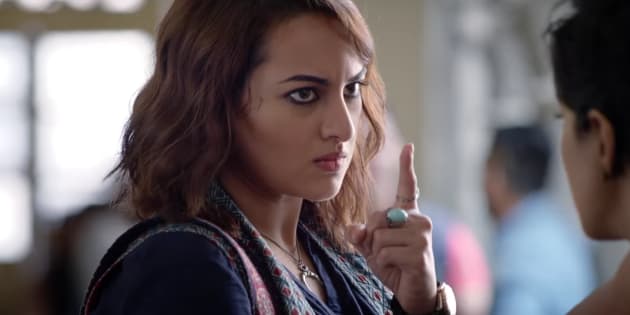This Sonakshi Sinha starrer has a few enjoyable moments but ultimately sabotages itself.

Ah, the 'feminist action flick', which is just a regular action flick except the protagonist is a woman. A.R. Murgadoss, the South Indian filmmaker who directed the inexplicably popular Hindi remake of his own Ghajini (2008) and the Akshay Kumar starrer Holiday (2013), returns to Hindi cinema this week with Akira, starring Sonakshi Sinha as the eponymous character with fists of fury.
The director establishes what kind of film Akira aims to be quite early on, in a flashback sequence set in Jodhpur, Rajasthan. Young Akira, who has been traumatised by an acid attack on her friend that she witnessed first-hand, is egged on by her mute teacher father (Atul Kulkarni, in a special appearance) to confront three potentially dangerous men — one of whom was behind said acid attack — all by herself.
Let me reiterate: we're talking about a pre-teen girl in a school uniform who has had maybe a few years of martial arts training (a character trait introduced out of the blue during this very scene) squaring off against multiple grown men (did I mention they have no problems throwing acid at people's faces). Winning at fatherhood only, boss.
Anyway, what is made clear by then is that we're in for a 2 hour 20-odd minute ride that is not above resorting to contrivances, shaky logic or outrageous coincidences to further its story. A drama about corrupt policemen, blackmailers, and one incredibly plucky girl, Akira spends its first half being somewhat watchable — thanks mostly to an enjoyable performance by Anurag Kashyap (more on this later) — and its second becoming progressively more unbearable.
Having spent a few years in a remand home for the aforementioned fight she picked, Akira is suddenly asked told to shift to Mumbai to attend college as small towns like Jodhpur have limited options (not that this is a flaw, but I'd like to point out that two generations of my family have lived and studied in Jodhpur — which now has a population of over one million, by the way — and done just fine).
The movie then asks the viewer to chase two parallel tracks: one, in which the joint-smoking ACP Rane (Kashyap) and his associates try to cover up a crime that could make them very rich; and two, in which Akira tries to adjust to life in college, what with mysterious thefts in her hostel and a pixie-haired girl named Nikki (Teena Singh), an unconvincing bully.
Enough happens to sustain interest, but not with much finesse. Most of the supporting cast is either downright bad or not much to write home about. Raai Laxmi appears in a small-but-significant role and delivers a shockingly screechy performance. Veteran editor A Sreekar Prasad's cross-cutting keeps things moving along nicely, but the film occasionally looks tacky, with light sources clearly visible in some scenes (unless college canteens have giant spotlights nowadays). Predictably, after showing us a bunch of asshole cops, we get one who is squeaky-clean and Frances-McDormand-like — she is played by Konkona Sensharma. Unpredictably and unironically, her name is Rabia Sultan.
It is Kashyap's sleazy ACP Rane who ends up getting the lion's share of the best scenes and lines in the movie, and the man delivers (after quite a while, it must be said).
A more competent director would've also played up the moments of black humour — of which there are plenty in this script — and created wonderful ambiguities, but Murugadoss is so enamoured by the traditional hero(ine)-villain dynamic that he flat-out refuses to acknowledge them. For instance, a scene in which Rane is interrogating Gill's character ends in a manner that the Coen Brothers might have approved of; unfortunately the way the scene is treated, you end up laughing at it instead of with it. Ditto another scene, where an encounter is delayed because of reasons ranging from low cellphone battery to a worn-out engine belt — the whole thing falls flat because the director seems to be aiming for suspense rather than deadpan laughs.
Still, in terms of mainstream fare, there is some enjoyment to be found in Sinha's butt-kicking avatar, which is as unrealistic as any run-of-the-mill Bollywood movie, but a refreshing change nevertheless. The actress, who has often been criticised for taking uni-dimensional 'love interest' roles, gets to cross over to the other side and doesn't do too badly (although she isn't particularly memorable either).
It is Kashyap's sleazy ACP Rane who ends up getting the lion's share of the best scenes and lines in the movie, and the man delivers (after quite a while, it must be said). While perhaps guilty of not sounding Maharashtrian enough (not that it matters in a movie where authenticity doesn't seem to be a huge priority), his silken baritone salvages many moments.
However, during the messy end portion, which is brought on hurriedly via a string of unbelievable coincidences (people conveniently forget about certain characters, certain others are tracked down suspiciously easily, deus ex machina etc.), even Kashyap's performance loses steam. A last-ditch twist in the climax — inserted forcefully to give its heroine one last fight sequence — is so hard to swallow that the movie loses a fair amount of the cred it had built up before that. Make your characters fight as many people as you want to, but why must your film fight its own characters?

No comments:
Post a Comment